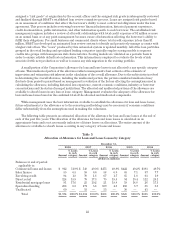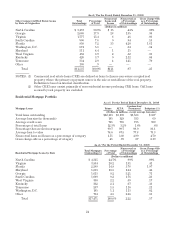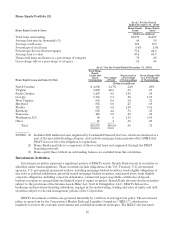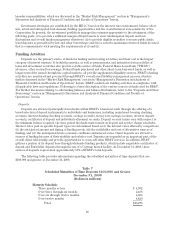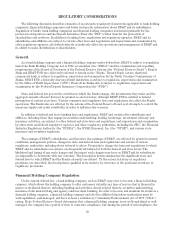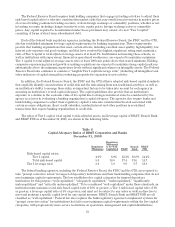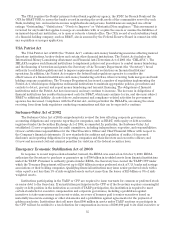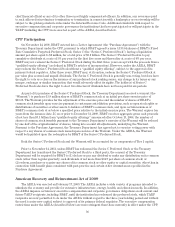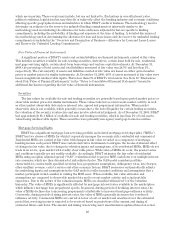BB&T 2008 Annual Report Download - page 32
Download and view the complete annual report
Please find page 32 of the 2008 BB&T annual report below. You can navigate through the pages in the report by either clicking on the pages listed below, or by using the keyword search tool below to find specific information within the annual report.There also are a number of obligations and restrictions imposed on bank holding companies and their
depository institution subsidiaries by federal law and regulatory policy that are designed to reduce potential loss
exposure to the depositors of such depository institutions and to the FDIC insurance fund in the event the
depository institution is insolvent or is in danger of becoming insolvent. For example, under requirements of the
Federal Reserve Board with respect to bank holding company operations, a bank holding company is required to
serve as a source of financial strength to its subsidiary depository institutions and to commit financial resources
to support such institutions in circumstances where it might not do so otherwise. In addition, the “cross-
guarantee” provisions of federal law require insured depository institutions under common control to reimburse
the FDIC for any loss suffered or reasonably anticipated by the DIF as a result of the insolvency of commonly
controlled insured depository institutions or for any assistance provided by the FDIC to commonly controlled
insured depository institutions in danger of failure. The FDIC may decline to enforce the cross-guarantee
provision if it determines that a waiver is in the best interests of the DIF. The FDIC’s claim for reimbursement
under the cross guarantee provisions is superior to claims of shareholders of the insured depository institution or
its holding company but is subordinate to claims of depositors, secured creditors and nonaffiliated holders of
subordinated debt of the commonly controlled insured depository institution.
Federal and state banking regulators also have broad enforcement powers over the Banks, including the
power to impose fines and other civil and criminal penalties, and to appoint a conservator (with the approval of
the Governor in the case of a North Carolina state bank) in order to conserve the assets of any such institution for
the benefit of depositors and other creditors. The North Carolina Commissioner of Banks also has the authority
to take possession of a North Carolina state bank in certain circumstances, including, among other things, when it
appears that such bank has violated its charter or any applicable laws, is conducting its business in an
unauthorized or unsafe manner, is in an unsafe or unsound condition to transact its business or has an impairment
of its capital stock.
Payment of Dividends
BB&T is a legal entity separate and distinct from its subsidiaries. The majority of BB&T’s revenue is from
dividends paid to BB&T by Branch Bank. The Banks are subject to laws and regulations that limit the amount of
dividends they can pay. In addition, BB&T and the Banks are subject to various regulatory restrictions relating
to the payment of dividends, including requirements to maintain capital at or above regulatory minimums, and to
remain “well-capitalized” under the prompt corrective action regulations summarized elsewhere in this section.
Federal banking regulators have indicated that banking organizations should generally pay dividends only if
(1) the organization’s net income available to common shareholders over the past year has been sufficient to fully
fund the dividends and (2) the prospective rate of earnings retention appears consistent with the organization’s
capital needs, asset quality and overall financial condition. North Carolina law states that, subject to certain
capital requirements, the board of directors of a bank chartered under the laws of North Carolina may declare a
dividend of as much of that bank’s undivided profits as the directors deem expedient. BB&T does not expect that
these laws, regulations or policies will materially affect the ability of Branch Bank to pay dividends.
Capital
Each of the federal banking agencies, including the Federal Reserve Board, the FDIC and the OTS, has
issued substantially similar risk-based and leverage capital guidelines applicable to banking organizations they
supervise, including bank holding companies and banks. Under the risk-based capital requirements, BB&T and
the Banks are each generally required to maintain a minimum ratio of total capital to risk-weighted assets
(including certain off-balance sheet activities, such as standby letters of credit) of 8%. At least half of the total
capital must be composed of common shareholders’ equity excluding the over- or underfunded status of
postretirement benefit obligations, unrealized gains or losses on debt securities available for sale, unrealized
gains on equity securities available for sale and unrealized gains or losses on cash flow hedges, net of deferred
income taxes; plus certain mandatorily redeemable capital securities; less nonqualifying intangible assets net of
applicable deferred income taxes and certain nonfinancial equity investments. This is called “Tier 1 capital.” The
remainder may consist of qualifying subordinated debt, certain hybrid capital instruments, qualifying preferred
stock and a limited amount of the allowance for credit losses. This is called “Tier 2 capital.” Tier 1 capital and Tier
2 capital combined are referred to as total regulatory capital.
32


